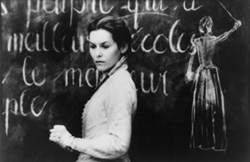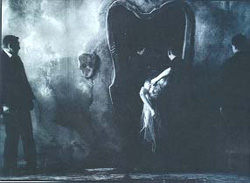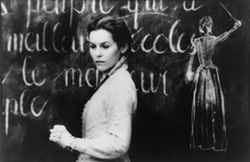Part of Fall 1996
Like a nightmare recalled in an inebriated stupor Institute Benjementa is both poignant and fleeting. It is the first live-action narrative film by the celebrated Brothers Quay whose animation has graced both the film festival circuit (The Comb, Street of Crocodiles) and MTV (most notably Peter Gabriel’s Sledgehammer). The film follows the path of Jakob, “a paranoid Everyguy”, who has enrolled at the Institute Benjementa to train as a butler. As Jakob is drawn through the trials and tribulations of his training he becomes antagonistic to the school’s arcane and enigmatic regimen. Though he is no heroic rebel (he’s more Buster Keaton than Bruce Willis) his persistent curiosity about the directors of the school, a tyrannical headmaster (played by Fassbinder star Gottfried John) and his repressed sister (Alice Krige), leads to a gradual erosion of their control and the ultimate collapse of the school.
The introduction of live characters to the standard Quay palette leads to a work which is arguably one of the most idiosyncratic films of all time. The story originates from the novella Jakob von Gunten by Robert Walser who reputedly influenced Kafka. While the film is clearly an absurdist fairy-tale, evocative of fin-de-siecle Euro-angst, its labyrinthine investigation of desire and emancipation also suggests the Surrealism of Bunuel and Dali. Shot in luminous black & white the lighting and composition are indebted to Expressionist cinema of the silent era. Spin magazine described it as “Eraserhead in Prague”.
Notes:
Swiss writer Robert Walser wrote eight novels, many poems, and over 1,000 short stories in the first thirty years of this century before committing himself as a schizopherenic to a psychiatric institution, where he remained for the rest of his life. His work, notable for making the commonplace remarkable, delt obsessively with the figure of the restless anti-hero, the dark-souled nobody. His novella, Jakob Von Gunten, was a major influence on the writings of Kakfa, and has now inspired Institute Benjamenta (or This Dream People Call Human Life) the first feature film by the Brothers Quay.
The eerie atmosphere of Institute Benjamenta (1995, 105 min.) recalls the Brothers Quay’s previous short films, which employed puppetry, animation and live action to explore the shadowy recesses of the tortured, loveless soul… Through the examination of relations between master and servant, instructor and pupil, the obsessive, fetishistic vision of these unique filmmakers reveals the fundamental social and psychological operations of control and submission, desire and repression. (Kay Armatage)
The extraordinary Brothers Quay are two of the most original filmmakers to have emerged in the past decade. These identical twins, Timothy and Stephen, were born outside Philadelphia, Pennsylvania in 1947, but live in London in publicity-shy seclusion making their unique and innovative films under the aegis of Koninck Studios. They studied at the Philadelphia College of Art, then at the Royal College of Art in London. Devotees of the Czech animation maestro Jan Svankmajer (Faust ), the Quays have produced a host of short animated films (Nocturna Artificalia, 1979, Street of Crocodiles, 1986, Stille Nacht I, 1988, The Comb, Anamorphosis, 1991, Are We Still Married?, Can’t Go Wrong Without You, Long Way Down (Look What the Cat Drug In) and Tales from the Vienna Woods, 1992/93) as well as documentaries (Igor – The Paris Years Chez Pleyel, The Cabinet of Jan Svankmajer, 1984), rock videos (Peter Gabriel’s Sledgehammer) and numerous decors for theatre and opera productions (Janacek’s The Makropoulos Case at Covent Garden in 1996).


